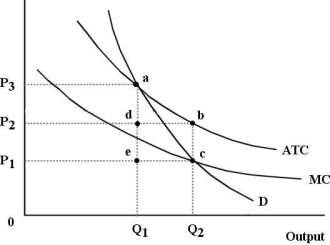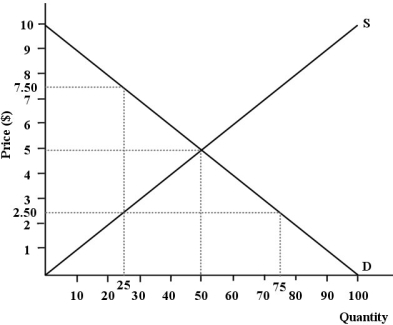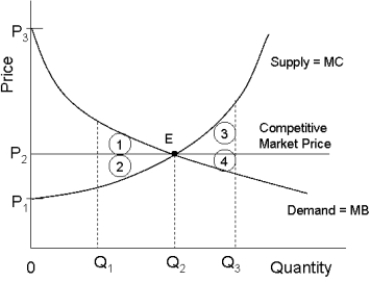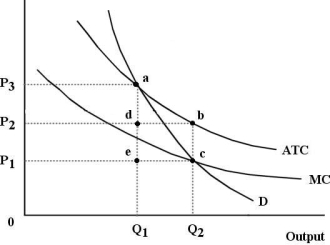A) imperfectly competitive markets are regulated.
B) the economy's resources are fully employed.
C) least- cost production techniques are employed by all firms.
D) the marginal cost equals price for all goods.
E) the marginal costs of all firms in an industry are equal.
Correct Answer

verified
Correct Answer
verified
Multiple Choice
Consider three firms, A, B and C, all producing kilos of potatoes (per year) in a perfectly competitive market. The diagrams below show marginal cost curves for each of the three firms.  FIGURE 12- 1
-Refer to Figure 12- 1. Suppose each of Firms A, B, and C are producing 500 kilos of potatoes. Which of the following statements correctly describes the productive efficiency of this industry?
FIGURE 12- 1
-Refer to Figure 12- 1. Suppose each of Firms A, B, and C are producing 500 kilos of potatoes. Which of the following statements correctly describes the productive efficiency of this industry?
A) The total output of 1500 kilos is the productively efficient output for this industry, so no reallocation is necessary.
B) It is not possible to say whether this industry is productively efficient because we do not know the market price of the product.
C) Productive efficiency would be achieved if Firm B produced all the output, since it has the lowest MC for the production of 500 kilos.
D) It is not possible to say whether this industry is productively efficient because we do not know the average costs for each firm.
E) It is possible to reduce the total cost of the given output by reallocating production among the three firms.
Correct Answer

verified
Correct Answer
verified
Multiple Choice
One method of regulating a natural monopoly is known as average- cost pricing. Using this method, the regulator requires that the price be set equal to average
A) internal cost.
B) variable cost.
C) total cost.
D) marginal cost.
E) fixed cost.
Correct Answer

verified
Correct Answer
verified
Multiple Choice
Consider two firms, A and B, that are producing the same product but with different average costs. Economists say this situation reflects a problem of
A) economic inefficiency.
B) unemployed resources.
C) productive inefficiency.
D) allocative inefficiency.
E) - not necessarily any of the above.
Correct Answer

verified
Correct Answer
verified
Multiple Choice
A major aim of Canadian competition policy is to
A) achieve a perfectly competitive market structure in all markets in the Canadian economy.
B) protect Canadian companies from unfair foreign competition.
C) monitor the pricing practices of crown corporations.
D) eliminate oligopolies and the allocative inefficiency that they entail.
E) prevent further concentration of industries where such concentration would lessen competition.
Correct Answer

verified
Correct Answer
verified
Multiple Choice
The diagram below shows the market demand curve and the cost curves for a single firm.  FIGURE 12- 6
-Refer to Figure 12- 6. Suppose this firm is being regulated using a policy of marginal- cost pricing. To maintain the resulting level of output
FIGURE 12- 6
-Refer to Figure 12- 6. Suppose this firm is being regulated using a policy of marginal- cost pricing. To maintain the resulting level of output
A) the demand curve would have to shift down.
B) the government would have to accept the allocative inefficiency associated with this level of output.
C) the regulator would have to allow the firm to keep the monopoly profits at this level of output.
D) the government would have to subsidize the firm or it will eventually shut down.
E) the average total cost curve would have to shift up.
Correct Answer

verified
Correct Answer
verified
Multiple Choice
The diagram below shows supply, demand, and quantity exchanged of Monday matinee movie tickets. Assume it is a perfectly competitive market.  FIGURE 12- 4
-Refer to Figure 12- 4. What is the total revenue received by the sellers of this product at the allocatively efficient level of output?
FIGURE 12- 4
-Refer to Figure 12- 4. What is the total revenue received by the sellers of this product at the allocatively efficient level of output?
A) $250
B) $125
C) $500
D) $375
E) $5
Correct Answer

verified
Correct Answer
verified
Multiple Choice
The larger the minimum efficient scale of firms, ceteris paribus, the
A) more likely a concentrated market will improve allocative efficiency.
B) greater the number of firms comprising an industry.
C) greater the tendency toward monopoly inefficiency.
D) lower the advantages of large- scale production.
E) more likely a concentrated market will improve productive efficiency.
Correct Answer

verified
Correct Answer
verified
Multiple Choice
Suppose we compare two monopolists with identical cost and demand conditions. Monopolist A charges a single price. Monopolist B engages in price discrimination, charging a different price for different units of the product. Which one of the following statements is correct?
A) B will generally produce more than A, resulting in less deadweight loss.
B) A will produce less than B, resulting in smaller deadweight loss.
C) A and B will both produce the same amount.
D) A will produce more than B, resulting in larger deadweight loss.
E) B will produce less than A, resulting in a larger deadweight loss.
Correct Answer

verified
Correct Answer
verified
Multiple Choice
An allowable defense for a merger according to Canada's Competition Bureau is that
A) merging firms find it easier to decide how they will share the market.
B) merging firms are more profitable because they no longer have to compete with one another.
C) larger firms are easier to regulate.
D) merged and therefore bigger firms are better placed to compete globally.
E) the gains in efficiency resulting from the merger more than offset any reductions in competition.
Correct Answer

verified
Correct Answer
verified
Multiple Choice
The diagram below shows the demand and supply curves in a perfectly competitive market.  FIGURE 12- 5
-Refer to Figure 12- 5. If output in this market were Q3, and the price were still P2, the loss in consumer surplus relative to the competitive equilibrium would be illustrated by area
FIGURE 12- 5
-Refer to Figure 12- 5. If output in this market were Q3, and the price were still P2, the loss in consumer surplus relative to the competitive equilibrium would be illustrated by area
A) 3 + 4.
B) 1.
C) 3.
D) 4.
E) 2.
Correct Answer

verified
Correct Answer
verified
Multiple Choice
In principle, a comparison of the long- run equilibrium of competitive and (single- price) monopoly industries leads to the following conclusion:
A) the competitive industry is consistent with allocative efficiency whereas the monopoly is not.
B) neither industry is capable of allocative efficiency.
C) the competitive industry will achieve productive efficiency but the monopoly will not.
D) both the competitive industry and the monopoly will allocate resources inefficiently.
E) both the competitive industry and the monopoly will allocate resources efficiently.
Correct Answer

verified
Correct Answer
verified
Multiple Choice
A natural monopoly exists when
A) a firm produces a product essential to national security.
B) a firm is able to operate at the minimum point of its long- run average total cost curve.
C) one firm can most efficiently supply the entire market demand.
D) a firm has a government charter to be the sole producer of some good.
E) only one firm is supplying a natural resource.
Correct Answer

verified
Correct Answer
verified
Multiple Choice
The diagram below shows the market demand curve and the cost curves for a single firm.  FIGURE 12- 6
-Refer to Figure 12- 6. Suppose this firm is being regulated using the policy of marginal- cost pricing. The resulting price and output would be
FIGURE 12- 6
-Refer to Figure 12- 6. Suppose this firm is being regulated using the policy of marginal- cost pricing. The resulting price and output would be
A) P1 and Q2.
B) P2 and Q2.
C) P1 and Q1.
D) P3 and Q2.
E) P3 and Q1.
Correct Answer

verified
Correct Answer
verified
Multiple Choice
According to economist George Stigler, the process of regulating firms with market power becomes suspect over time because
A) regulators shift from protecting the consumer to protecting the regulated firm from competition.
B) regulation leads to corruption of political parties.
C) regulated firms devise methods to circumvent the regulations.
D) regulators impose additional costs on regulated firms because they are expected to accomplish other social goals.
E) regulated firms are allowed to expand into other markets and drive out competing firms.
Correct Answer

verified
Correct Answer
verified
Multiple Choice
Productive efficiency (at the level of the firm) is a goal that is sought
A) by no firms in any market.
B) by profit- maximizing firms in all market structures.
C) only by perfectly competitive firms.
D) only by profit- maximizing imperfectly competitive firms.
E) only by profit- maximizing firms in an oligopolistic market structure.
Correct Answer

verified
Correct Answer
verified
Multiple Choice
Which of the following is the definition of producer surplus?
A) the price of a good minus the marginal cost of producing it, summed over the quantity produced.
B) quantity produced in excess of the allocatively efficient amount.
C) the total revenue received by the producer for a good minus the total cost of producing that good.
D) the price of a good minus the cost of producing it.
E) the revenue received for a good, minus the cost of producing it.
Correct Answer

verified
Correct Answer
verified
Multiple Choice
The production possibilities boundary shows possible combinations of guns and butter that can be produced by a country. The lower diagram shows demand and supply for butter.  FIGURE 12- 2
-Refer to Figure 12- 2. Suppose this economy is allocatively efficient at Q1 units of butter. Now suppose there is an increase in demand for butter from D to D1. After this shift in demand,
FIGURE 12- 2
-Refer to Figure 12- 2. Suppose this economy is allocatively efficient at Q1 units of butter. Now suppose there is an increase in demand for butter from D to D1. After this shift in demand,
A) the price of guns (relative to the price of butter) rises and the economy moves to point (a) on the PPB.
B) the marginal value to consumers of butter is greater than the marginal cost to producers; the price of butter (relative to the price of guns) rises; the economy moves to output Q2 of butter and point (c) on the PPB.
C) the supply curve will shift up to S1 and allocative efficiency will be maintained.
D) the marginal value to consumers of butter is less than the marginal cost to producers; the price of butter (relative to the price of guns) rises; the economy moves to output Q2 of butter and point (c) on the PPB.
E) the increase in the price of butter (relative to the price of guns) will cause the demand curve to shift back down to D and allocative efficiency will be maintained.
Correct Answer

verified
Correct Answer
verified
Multiple Choice
Monopoly is allocatively inefficient because
A) the price exceeds the marginal cost of the last unit produced.
B) the firm has no incentive to maximize profits.
C) the opportunity cost exceeds the marginal cost of the last unit produced.
D) the marginal cost exceeds the average cost for the last unit produced.
E) lower costs could be achieved.
Correct Answer

verified
Correct Answer
verified
Multiple Choice
In Canada, a significant challenge for the Competition Bureau when reviewing a possible merger between firms in a concentrated industry is to
A) impose effective entry barriers to the industry.
B) determine whether monopoly no longer poses a threat to the Canadian economy.
C) determine whether efficiency gains make the merger desirable.
D) allow those mergers that lead to larger firms that are easier to regulate.
E) determine whether criminal charges are required due to unlawful collusion.
Correct Answer

verified
Correct Answer
verified
Showing 81 - 100 of 109
Related Exams